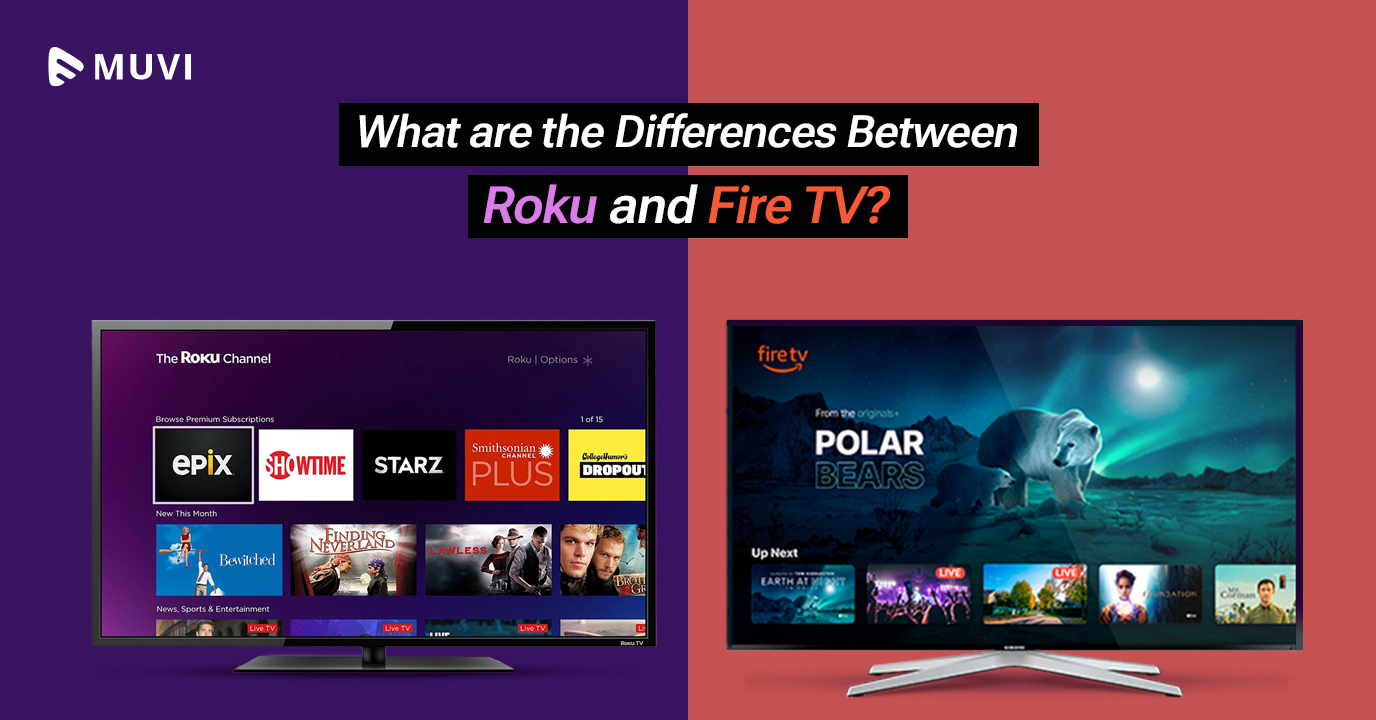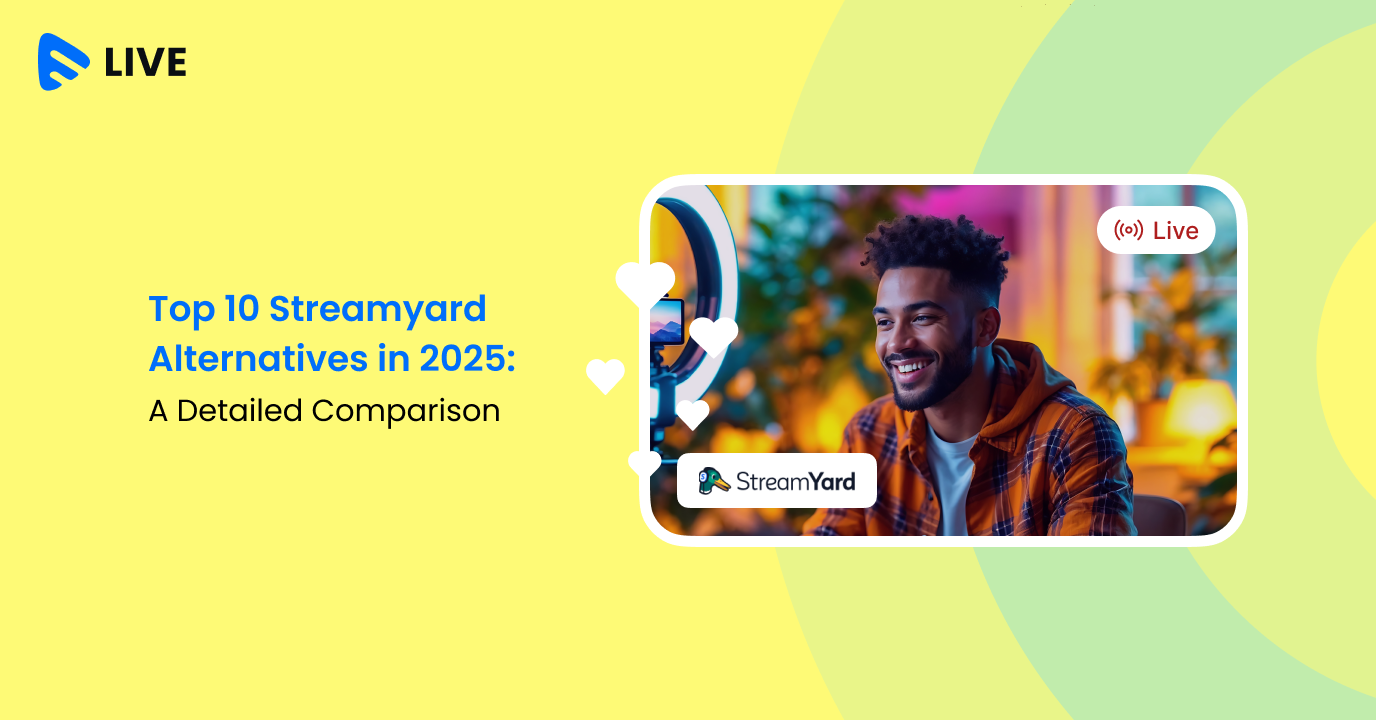Roku vs Fire TV- when you think of streaming online content, these two devices are the most preferred options used by streamers. However, while Roku and Amazon Fire Stick are both popular, they differ in several ways. Both offer robust features, but they cater to different user needs. This blog will compare Roku and Fire Stick in-depth and explain how Muvi One can help businesses launch their streaming apps across these platforms.
Easy access to a broad range of movies, shows, games, series, sports, music, and others, better user interface, affordability – these are some of the common driving factors to their high demand among the audience that streaming business players are leveraging to expand their audience base, scale up their business and increase their profit.
If you too are running an OTT streaming business or planning for the same, then you must have a clear idea on both Roku and Amazon Fire TV, the differences between them, their respective ecosystems, growth scope, and more. And in this blog, we are going to walk you through all you need to know about Roku vs Fire TV.
What Is Roku TV?
Roku refers to hardware digital media players that are manufactured by Roku, Inc., an American media streaming devices company. Roku TV is a streaming box that connects to your smart television with the Roku operating system pre-installed. With Roku TV installed you can get access to a diverse range of channels and apps. from live TV to on-demand content, you can get access to a variety of content with Roku TV.
Founded by Anthony Wood in 2002, the first Roku model was developed in May 2008 in collaboration with Netflix and since that time several generations of Roku were released as shown below.
Date | Roku Generation/Model |
May 2008 | First Generation Roku – Roku DVP N1000 |
July 2011 | Second Generation Roku – Roku 2 HD, XD, and XS |
March 2013 | Third Generation Roku – Roku 3 and Roku 2 |
October 2015 | Fourth Generation Roku – Roku 4 |
September 2016 | Fifth Generation Roku – Low End Roku Express, Roku Express+, High End Roku Premiere, Roku Premiere+, and Top-of-the-Line Roku Ultra |
October 2017 | Sixth Generation Roku |
September 2018 | Seventh Generation Roku |
September 2019 | Eighth Generation Roku |
September 2020 | Ninth Generation Roku – Updated Roku Ultra, Roku Streambar, 2-in-1 Roku and Soundbar Device |
September 2021 | Tenth Generation Roku – Roku Streaming Stick 4K, Roku Streaming Stick 4K+, Updated Roku Ultra LT, Roku OS 10.5 |
Roku TV: Key Features
- Built-in Roku OS – Provides a streamlined interface for accessing multiple streaming services.
- Great Content – Roku TV boasts an amazing content library from movies to TV episodes to live TV. It even lets you watch super clear 4K and HDR content.
- User Friendly Interface – Roku TV flaunts a splendid user interface which is very easy to navigate and find your preferred channels. There is also an option to eliminate channels which you dislike.
- Voice Control – The voice control feature of Roku TV is pretty good and lets you find and watch your favorite stuff without typing anything.
- Screen Mirroring – Roku TV is screen mirroring enabled and lets you show off what’s on your phone or tablet right on your TV.
Private Listening Mode – Users can listen via headphones connected to the Roku app.
What Is Amazon Fire TV?
Amazon Fire TV, just like Roku, is another popular streaming device that lets you access some great content on your TV. Simply out, it is a tool that connects to the Internet through Wi-Fi, just like Roku TV. It is part of Amazon’s ecosystem and integrates seamlessly with Alexa for voice control.
The first generation Fire TV was launched in April 2014 followed by several other releases as listed below. If you are interested in developing an app for Fire TV, you can explore the resources and tools available with Muvi to build Amazon Fire TV app.
Date | Fire TV Model | Fire TV Generation |
April 2014 | Original Model | First Generation Fire TV |
Late 2015 | Original Model | Second Generation Fire TV |
2017 | Original Model | Third Generation Fire TV – Fire TV with 4K Ultra HD and Alexa Voice Remote |
June 2018 | Fire TV Cube | First Generation Fire TV Cube |
September 2019 | Fire TV Cube | Second Generation Fire TV Cube Equipped With Hexa-Core Processor, Local Voice Control, Supports Dolby Vision, HDR10+, 4K Output |
October 2022 | Fire TV Cube | Third Generation Fire TV Cube Equipped With Octa-Core Processor, Supports 6e Ethernet/Wi-Fi networking, and Bluetooth 5.2 |
November 2014 | Fire TV Stick | First Generation Fire TV Stick |
October 2016 | Fire TV Stick | Second Generation Fire TV Stick – Fire TV Stick With Alexa Voice Remote |
October 2018 | Fire TV Stick | Fire TV Stick 4K |
October 2020 | Fire TV Stick | Third Generation Fire TV Stick |
October 2021 | Fire TV Stick | Fire TV Stick 4K Max with Updated Third Generation Alexa Voice and Wi-Fi 6 Support |
Features of Amazon Fire TV:
- Amazon Prime Integration – Fire TV Prioritizes Amazon Prime Video so you can easily access content from Prime Video channel.
- Voice-Controlled Navigation – Fire TV comes with Alexa-enabled remotes for hands-free control.
- Side-Loading Capabilities – Allows installation of third-party apps.
- Smart Home Integration – Connects with Amazon Echo and other smart devices.
- Multiple Hardware Options – Available in different versions like Fire TV Stick Lite, 4K, and Fire TV Cube.
- Gaming Support – If you are into gaming and want to play games on your TV, then Amazon Fire TV should be your go-to streaming device. It supports a whole suite of games and even throws in its own game controller.
Roku Vs Fire TV: The Key Differences
Apps, Channels, and Ecosystem
Roku offers a range of apps and channels including popular TV, free TV, live TV and music. Some of its top apps/channels include Netflix, Disney+, HBOmax, Roku Channel, YouTube TV, Hulu, Amazon Prime Video, Peacock, Spectrum, Vix, Pluto TV, NewsLive, Sling, Now, Vevo, Amazon Music, and Spotify, to name a few. It also supports Apple TV+ content. As a result, the streaming players can target a broad range of ecosystems for these respective apps/channels as well as for Apple TV+.
Unlike Fire TV, which has Prime Video pre-installed, Roku users must download the app from the Roku Channel Store, illustrating a difference in user experience.
Amazon Fire TV also offers a range of apps, and channels such as Peacock TV, YouTube, Tubi, Pluto TV, Paramount+, YouTube TV, to name a few. Also, it offers a wide range of games like Asphalt 8: Airborne, Beach Buggy Blitz, Vendetta Online, and many more. This also lets the streaming market players target the respective app/channel audiences and leverage the ecosystems. However, Amazon’s apps/channels are more emphasized in Fire TV for the obvious reason.
Roku and Fire TV apps/channels are available on Android and iOS, while Fire TV content are also compatible with Fire OS. Also, both Fire TV and Roku support private listing features.
User Interface
Roku comes with a catchy and simple-to-understand UI (User Interface) where the available apps and channels are displayed on the homepage and the menu is displayed on the left hand side.
One can easily navigate through the apps and channels on its home page or pick up from the list under menu such as movie store, TV store, streaming channels, settings, and others. Also, it offers a personalized feed and lets one find specific content based on genre, actor, director etc. as well as lets you add your preferred channels and access your favorite ones easily.
Fire TV, on the other hand, offers a simple and easy-to-navigate user interface. Its home page displays a streamlined and neat menu including live, your videos, movies, TV shows, settings, apps, and other options. While the home screen of Fire TV is not that neat and organized like Roku, it also personalizes your home page by featuring the most frequently watched Fire TV channels. Also, it recommends movies, shows, and series based on the viewers’ watch history.
Voice Control and Smart Home Integration
Equipped with voice control capabilities through its Enhanced Voice Remote, Roku allows users to search for content and control playback using voice commands. However, its smart home integration is relatively limited compared to Fire Stick.
Featuring an Alexa-enabled remote, Fire Stick offers robust voice control functionalities. Users can search for content, manage playback, and even control compatible smart home devices, making it a versatile addition to an Alexa-centric smart home setup.
Voice Control
Roku and Fire TV both come with voice control features. Not only does Fire TV function smoothly with Alexa but it lets you control other smart home devices with its voice controlled remote.
Roku’s built-in voice control executes your voice commands seamlessly and it works well with both Alexa and Google Assistant. Also, it lets you control smart home devices easily with voice commands.
Private Listening
Private listening is a feature that allows users to enjoy audio from their streaming device through headphones, ensuring that others in the room are not disturbed. Both Roku and Fire TV devices offer private listening capabilities, but they implement this feature differently.
Roku devices provide private listening through their mobile app, which is available for both iOS and Android. Users can connect their headphones to their phone or tablet and listen to audio from their Roku device. This feature is available on all Roku devices, including the Roku Streaming Stick and Roku TV, making it a versatile option for users who want to enjoy their content quietly.
On the other hand, Fire TV devices offer private listening through Bluetooth headphones. Users can pair their Bluetooth headphones with their Fire TV device and listen to audio without disturbing others. However, this feature is only available on Fire TV devices that support Bluetooth, such as the Fire TV Stick 4K and Fire TV Cube.
When it comes to private listening, Roku devices have a clear advantage. The convenience of using the Roku mobile app for private listening means users don’t need to worry about pairing their headphones with the device. Additionally, Roku’s private listening feature is available on all Roku devices, whereas Fire TV’s private listening feature is limited to certain models that support Bluetooth.
By offering a more user-friendly and widely available private listening option, Roku stands out as the better choice for those who prioritize this feature in their streaming experience.
Gaming
Amazon offers a dedicated gaming controller, allowing you to play a variety of games available through the Amazon Appstore. While Roku also provides casual gaming options, Fire Stick’s gaming experience is more robust and tailored to gamers. If gaming is a priority for you, the Fire Stick might be the better choice.
Video/Audio Quality
When it comes to video quality, Fire TV and Roku give tough competition to each other. Based on the specific devices, there can be variations in the video and audio quality and specifications as displayed below.
Fire TV/Roku Model | Video Streaming Quality | Dolby Vision Support |
Hisense RB Series 4K ULED Roku Smart TV | Up to 4K | Yes |
TCL Class 3-Series FHD LED Roku TV | Up to 1080p | No |
All-New Insignia 4K UHD Smart TV – Fire TV Edition | Up to 4K | No |
All-New Toshiba Smart HD TV – Fire TV Edition | Upto 1080p | No |
Roku Vs Fire TV: Hardware Specifications
Roku Streaming Stick 4K:
- Price: $50
- Picture Quality: 4K at 60fps
- Audio Quality: Dolby Atmos
- Storage: 4GB
- Memory: 1GB
- Wi-Fi: Dual-band
- Ports: HDMI 2.0b, USB for power
Amazon Fire TV Stick 4K:
- Price: $40
- Picture Quality: 4K at 60fps
- Audio Quality: Dolby Atmos
- Storage: 8GB
- Memory: 1.5GB
- Wi-Fi: Dual-band
- Ports: HDMI output, Micro-USB for power
Also Read: What is Fire TV? How Fire TV Works? – Everything You Need to Know
Roku Vs Fire TV: Which one Should you Buy?
While both have a bunch of good features to choose from, your choice would depend on your basic requirements.
Streaming Capabilities:
Both give you access to amazing movies, TV shows, web series, etc but there are some notable differences to check out. While Fire TV prioritizes Prime Video Content, Roku stands tall in terms of great variety of channels and apps. Roku also has its own Roku channel which is also a popular choice amongst users,
User Experience
When it comes to user experience, Roku tops the charts. Roku flaunts a user friendly home screen which is home to a variety of apps and channels making it easy for users to jump onto your favorite content as there are quite a lot of choices.
Also the search option for Roku works well over its competitor. For years, Roku was the only one offering universal search, which lets you search for a title and Roku would display all the different apps you can watch it on, along with how much it costs to rent or buy.
Fire TV’s search results have improved and even include AI powers, but they require more work to sift through. Also, Fire Stick promotes Amazon Prime Video content more than anything else so you might see more Amazon stuff on your home screen.
Roku Vs Fire TV: Building Roku and Amazon Fire TV Apps With Dedicated Developers
For businesses looking to launch their own branded streaming apps on Roku and Fire TV, partnering with experienced developers is essential. This is where Muvi One comes in.
if you want to develop streaming apps which works on both Roku and Fire TV, we have got you covered. Muvi One- our flagship product lets y ou develop a No-Code Platform in minutes wherein you can seamlessly build and launch Roku and Fire TV apps without any coding expertise.
Here is Why you Should Choose Muvi One:
- Multi-Device Deployment- Seamlessly deploy your app across multiple platforms, including Android, iOS, and smart TVs.
- Custom Branding- White-label solutions to align with your brand’s identity.
- Monetization Options- Supports various revenue models like SVOD, AVOD, and PPV.
- Security & Compliance- Ensures DRM protection, content encryption, and secure payments.
Ready to launch your own streaming app? Check out Muvi One today!
Roku Vs Fire TV: Market and Growth Scope
Roku and Fire TV both have lucrative global market shares and with the streaming industry expanding faster, the future holds even more growth scope for the streaming business players. Roku has over 36% share of the video streaming market in the U.S. itself, while the Roku TV OS has 6.4% share of the global smart TV streaming market. As stated in a recent market report, there are over 63 million active Roku user accounts around the globe as of 2022, while the yearly Roku revenue is over US $2.5 billion and is forecast to grow further. Also, Roku accounts for more than 15% of the US smart TV sales.
Fire TV, on the other hand, has over 50 million monthly active users with over 150 million Fire TV devices sold around the globe. Holding more than 28% share of the U.S. streaming box market, nearly 23% of the viewers use Fire TV in the U.S. itself. Also, a recent survey by Amazon revealed that the average watch time for Fire TV devices was 4 hours in 2021, up from 3 hours in 2020. This depicts the lucrative growth the Fire TV market and ecosystem offers.
The Bottom Line
Fire TV and Roku both offer growth opportunities to the streaming businesses by creating their own branded channels. Despite having their own sets of pros and cons, it is always a good idea to launch your own branded app/channel to target their respective ecosystems and leverage the growing market potential.
Muvi One, an one of its kind OTT platform, offers a complete solution to launch your own branded Roku as well as Fire TV app to unleash the potential of their growing ecosystems. Also, Muvi One offers several competitive solutions/advantages such as in-app purchase and subscription, multi-language support, deep linking, audience engagement tools, analytics and insights and many more.
Intrigued to try it out? Take a 14-day free trial today (no credit card required).














Add your comment